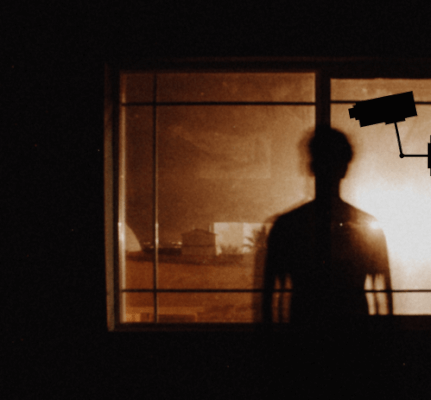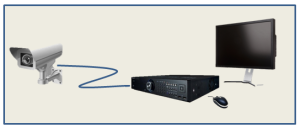Intruder! Do we need a security system?

Home and Business Security Options
Have you seen the ads showing a package thief caught in the act? Or the ad that shows the “escaping teenager” on the roof, caught because she set off an alarm when she opened her window? All these ads are designed to make you realize you need a security system! But while the ads are compelling, they really don’t tell the whole story behind the available technology.
In fact, they don’t make it at all clear where a simple self-contained security camera leaves off and where a comprehensive monitored security system begins.
If you’re a new business owner, or someone newly concerned about security and safety, take a look at the questions and answers below. They’ll help you come up with a shopping list customized for your personal needs.
Disclaimer: security equipment and commercial security “packages” change regularly, so as you shop, be sure you are comparing current offers. This year, many of these items are being featured as special deals, so watch for them!
Questions to ask about security
The first version of this article appeared in Emergency Plan Guide nearly four years ago. In the time since, some things have changed dramatically! The “classic” security camera set up shown in the image below – camera connected to DVR connected to monitor — still exists, of course. But in many cases, wires have been replaced by wireless connections. And now you can get the images sent right to your cell phone or tablet in addition to your computer monitor.
That’s not all that has changed. As you review the following questions, consider what you really need for your location and your circumstances. As you might expect, the more features you want, the more expensive the system.

“Do I want wired or wireless?”
Wires are reliable as long as they aren’t damaged or cut. In fact, they may be more reliable than wireless, which can suffer in extreme weather or because of electronic interference.
And of course, wireless systems can be hacked! (None of the most popular wireless systems has been shown to have flaws, but all can be hacked by a determined pro. Most likely, people wanting to break into your home aren’t hackers — they are thieves! They’ll look for the easiest targets. Make sure you follow all best cyber practices — changing defaults, using unique passwords, updating everything whenever there’s an update. Your system will be too hard to break for that average thief.)
So, whether you choose a wired system or a wireless may depend, then, on your location or your security level requirements. Think it through. Oh, and if components are wireless, they still need to be powered, so you’ll have to consider when and how to replace batteries or install back-up batteries.
“Should I manage the system myself, or have it professionally monitored?”
Basic systems are set up to alert you by phone of activity or of a breach. Activity could be as simple as someone approaching the front door. You could, of course, miss the alert if your phone isn’t operating or isn’t nearby.
A monitored system reacts to a broader set of activities, and when it detects a breach, it reaches out to alert the monitoring company, which then alerts you and/or others, including perhaps police or fire.
Whereas a basic system is pretty much one purchase and a DIY install, a monitored system could involve service personnel to guide you through the installation. Once the threat of COVID is gone, they may actually do the installation for you. This may include installing a number of connectors, monitors and cameras and tying the system in to your home for business computer network. Naturally, you might have to pay for that personal installation service.
You will have to pay for monthly monitoring, as well. Some services wrap the cost of the equipment into the cost of monitoring. Others charge for the equipment up front, so their monitoring fees are much lower.
Costs vary widely. Equipment costs for a home system start as low as $100 for a single camera but are more likely to be twice or three times that much. (Even a simple business location will likely be more expensive in part because there are more rooms and more spaces to monitor.) Monthly monitoring costs may add as little as $10/month but most monitoring companies fees seem to be in the $39 –$59/month range for home services. Some companies even offer “advanced” monitoring that connects directly to police and first responders, saves your video, etc. (Watch for “sign-up specials” you can take advantage of!) Some companies require a contract; others don’t.
“Do I need indoor or outdoor security?”
Outdoor “barrel” or “bullet” security cameras (as shown in the illustration above) have a hood that protects them from the weather. “Dome” style cameras, with a curved face, are most popular indoors, and can also be weatherproof for outdoor use. (They have an advantage in that you can’t tell which direction the camera is pointing. You’ll often see them in casinos or in other public places.)
The latest models of doorbell security cameras are smaller, best described as a simple box with a small camera lens – not too dissimilar to the camera in your smart phone.
A complete system may have a variety of camera types. The main thing to remember: while an outdoor camera can be used indoors, the reverse is not necessarily true.
“Do I want an alarm only, or do I want to see video?”
The simplest video systems run continuously, without interruption. If something happens, it is caught on the tape. (You’ve surely seen videos showing convenience store robberies, or scenes from street cameras.) When the tape is filled up, it is stored for a given period of time and then written over.
A continuous video creates hours’ worth of images that are difficult to search through if you need footage for insurance or crime purposes.
So, you probably want a motion-activated system for your home or business, something that you can set to complement known traffic patterns. Movement or a change in condition (window being opened, for example) sets off an alarm that can go to your smart phone or computer, or, as already described, to a monitoring service. Movement can also start a camera that takes still photos or video that you can view on a computer screen in your office or send to your smart phone.
“What quality picture can I expect?”
The question really is, how much detail do you actually need? Do you need to be able to recognize faces on a 6 x 12 foot front porch? Or read license plates 30 yards away in the company parking lot? Think about how far away the object will be and the horizontal distance you want to cover.
The more detail you want, the higher the price of the equipment you’ll need. In many cases, however, you do NOT necessarily need the highest quality.
Having cameras with varifocal lenses will allow you to set the same camera for different uses. Some versions are P/T/Z – can be panned, tilted and zoomed remotely, for utmost flexibility.
“What about nighttime views?”
Most cameras have the infrared night vision built in, and automatically switch from day to night mode. Some cameras are paired with separate, motion-activated spotlights to provide the amount of light necessary for filming.
“Do I hear and can I speak to the person being filmed?”
The porch camera ads on TV show the homeowner telling the intruder to get lost. (Or you hear a friendly dad’s voice acknowledging the arrival of the kids.) Being able to hear and speak to the person who has activated the alarm are again additional features. They will cost more and require more bandwidth in the system.
LEGAL CAUTION: The above paragraph describes SPEAKING to another person via your security system. RECORDING a person without his or her knowledge is a whole different thing! In fact, Federal Wiretap Laws specifically prohibit recording unless at least one person in the conversation knows recording is taking place. (In California where we live, both parties must be aware of the taping.) So before you invest in a camera with audio recording capabilities, make sure you know the law in your state. You probably don’t want this capability!
OK, so much for the basic choices. Now . . .
“What additional features might I want?”
Some monitored home security systems offer more than just the surveillance and intrusion features we’ve discussed so far. Options could include:
- Panic buttons – Press to call for help if you are threatened in your home. Silent alert goes to monitoring service and to police.
- Life support systems – Press to call for medical help. This is the so-called “life alert.”
- Fire and CO alarms — These can be added to the system to alert residents and also the monitoring company in an emergency of this type.
And the final important question . . .
“What kind of customer support will I get – and what will it cost?”
Are you buying from a third-party distributor or the manufacturer? The amount or quality of support will vary dramatically. Before you buy, make sure you will have access to full documentation, at least, and check on the terms of the guarantee.
If you decide on a monitored service, you’ll want to know even more details before you sign on the dotted line. For example . . .
- Will the company set an appointment and come to my home/office to do the installation, or am I responsible for installing the equipment?
- Do I pay extra if they do the installation and set up?
- Must I buy all the equipment from the monitoring company? What if I already have some cameras I want to use?
- How do I get repairs if the equipment stops working?
- What sort of contract is required? (How many months?)
- Is there a fee to discontinue the service?
So now, if you’re ready to shop . . .!
Three examples of basic security camera systems
I picked these three best-selling models because they had consistently good reviews while demonstrating the variety of features discussed above. As you can see, prices vary. Click on the images or links for full details and to get exact prices at Amazon.
Reolink, A straightforward yet complete wired set-up with extra high-quality camera and continuous video. Note that when you get to Amazon to shop, you will find a number of “packages” containing this basic component.

Simplisafe – popular wireless home security system that “understands” Alexa and Google Assistant. No contract required (although professional monitoring is available). (I have to admit that I can’t resist the Simplisafe ad where Robbert says “Entrez vous!” to the pizza delivery guy.) Again, many individual components and different packages.

Ring Doorbell Pro uses existing doorbell wiring. Ring continues to get a lot of chatter on our local neighborhood Nextdoor website. People seem very pleased with their improved security. And prices have come down since we last looked. Remember that this is truly a doorbell, and not a whole house system.
Here’s the basic Pro version to get you started on your shopping.

If you have experience with any of these systems, or with a different system, please let us know so we can continue to update this guide!
Virginia Nicols
Your Emergency Plan Guide Team
